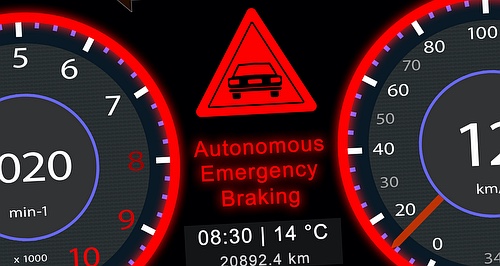Make / Model Search
News - General News - SafetyADR 98/00 implementation imminentMarch 1 import-by deadline nears for new vehicles equipped without latest AEB tech20 Jan 2025 By MATT BROGAN MANDATORY changes to the Australian Design Rule (ADR) relating to autonomous emergency braking (AEB) will take force on vehicles imported from 1 March 2025.
The introduction of ADR 98/00 harmonises local requirements with the globally recognised United Nations Regulation No. 152 and requires all new vehicles sold on the Australian market to be fitted as standard with the latest car-to-car AEB technology.
Under the changes, all new vehicles imported to Australia from the beginning of March must be equipped with AEB systems that adhere to strict parameters related to braking force, operational speed and reaction time.
As a result, some popular vehicle models may no longer be available from the showroom floor.
The rule change spells the end-of-the-line for models including petrol-powered Fiat 500 and related Abarth variants, certain LDV G10 and V80 models, the Mahindra Pik-Up, current generation Mitsubishi ASX, Mitsubishi Eclipse Cross, and Mitsubishi Pajero Sport, older Renault Kangoo and Trafic models, and remaining Suzuki Baleno, Ignis and S-Cross new stock.
Older high-performance and luxury models including remaining Aston Martin DB11 and DBS new stock, remaining Lamborghini Aventador and Huracan new stock, and selected Porsche 718 variants will also face the axe.
According to UN Regulation 152, the intention of the changes means to establish uniform provisions for AEB systems fitted to all new vehicles.
It states that new AEB technology shall “automatically detect an imminent forward collision, provide the driver with an appropriate warning and activate the vehicle braking system to decelerate the vehicle with the purpose of avoiding or mitigating the severity of a collision in the event that the driver does not respond to the warning”.
Further, the regulations which mirror those of ADR 98/00 add that “in the case of failure of the system, the safe operation of the vehicle shall not be endangered”, and that “any conscious action by the driver may override the system”.
Importantly, and perhaps as a note to many of the vehicles already on sale locally with questionable ADAS calibrations, UN Regulation 152 states that “actual conditions and features in the real world should not result in false warnings or false braking to the extent that they encourage the driver to switch the system off”.
Speaking previously on the adopting of ADR 98/00, ANCAP Safety chief executive officer Carla Hoorweg said the latest AEB technology has “consistently been shown to improve safety outcomes” and will ensure “100 per cent of new Australian vehicles will have the benefit of AEB from March 2025”.
Ms Hoorweg said AEB has been shown to reduce police-reported crashes by 55 per cent, rear-end crashes by 40 per cent, and vehicle occupant trauma by 28 per cent.
“These safety benefits are expected to improve further following the introduction of the ADR and evolution in the sophistication of AEB systems being encouraged through ANCAP’s safety rating criteria,” she added.
“It is estimated that the implementation of ADR 98/00 and 98/01 will save 580 lives and avoid 20,400 serious and 73,340 minor injuries – net benefit of $1.9 billion.”
Further tightening of AEB criteria will take place from August next year (2026) when Australian Design Rule 98/01 is mandated. The ruling implements the mandatory inclusion of car-to-pedestrian AEB on all new vehicles sold, again mirroring the requirements outlined under UN Regulation 152.
The ruling will apply to all passenger cars, off-road passenger vehicles, and light goods vehicles (MA, MB, MC and NA category vehicles) from 1 August 2026.
It is likely that more vehicles will be axed from the Australian new car market as tougher safety new rules come into force.  Read more |
Click to shareGeneral News articlesResearch General News Motor industry news |












Facebook Twitter Instagram